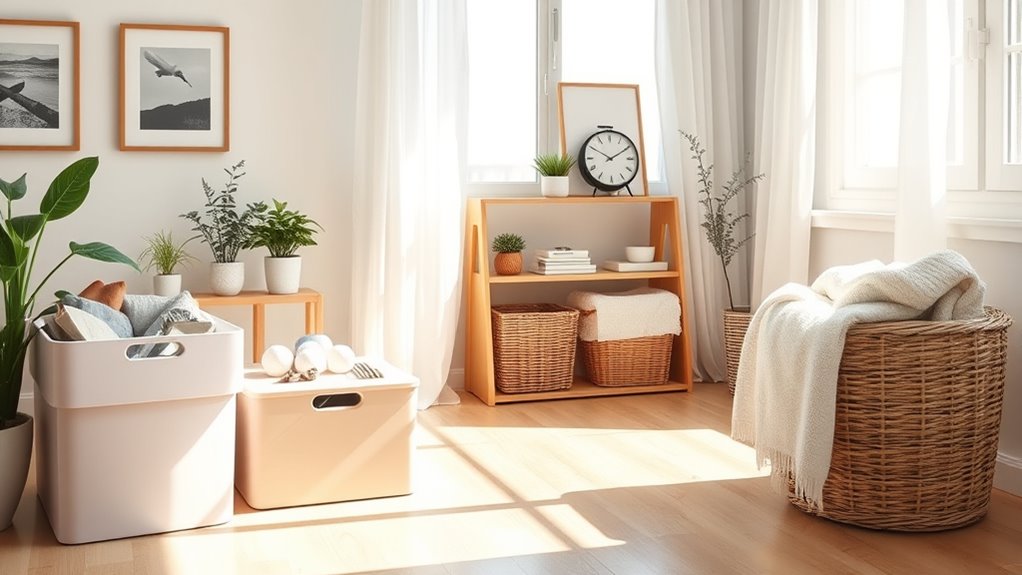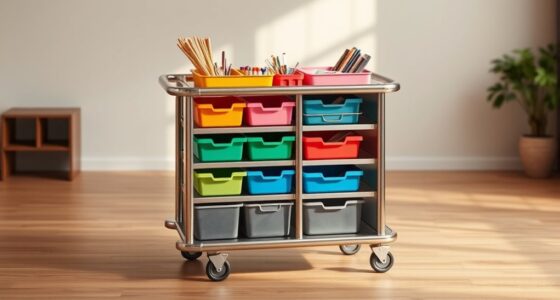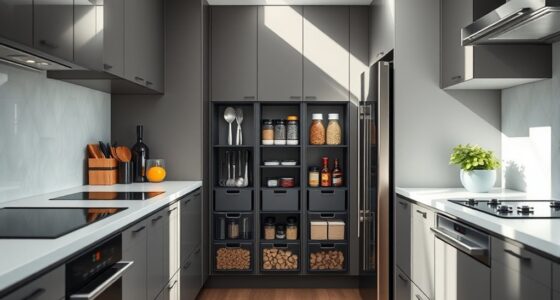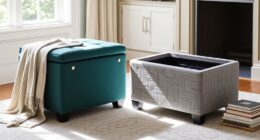To tackle clutter and create a fresh start, I believe every messy home needs four essentials: a solid plan, basic organization tools, a mindset shift, and regular decluttering habits. First, set clear goals for what you want to achieve. Then, gather bins or boxes to sort items effectively. Adopting a minimalist mindset helps you let go of unnecessary items. Finally, schedule regular maintenance to keep clutter at bay. Want to learn more about these essentials? Let's explore further!
Key Takeaways
- Decluttering Plan: Create a step-by-step decluttering strategy, focusing on one area at a time to avoid overwhelm and maintain motivation.
- Donation Boxes: Keep designated boxes for items to donate, encouraging a mindset of letting go and benefiting others in need.
- Organizational Tools: Invest in storage solutions like bins, shelves, and drawer organizers to streamline belongings and promote efficient use of space.
- Time Management: Schedule specific decluttering sessions each week to build consistency and establish a routine, preventing clutter from accumulating again.
- Mindfulness Practices: Incorporate mindfulness techniques to confront emotional attachments, helping to ease the decision-making process during decluttering.
The Sentimental Persons Guide to Decluttering

If you're someone who struggles with letting go of sentimental items, then "Decluttering Essentials for a Fresh Start" is the perfect guide for you. This book resonated with me as I learned to confront my emotional attachments. It provided practical strategies like grouping similar items together, which made the overwhelming task of decluttering more manageable. I found it liberating to realize that gifts shouldn't feel like obligations. By sharing personal stories, the author helped me understand my clutter challenges. It's not just about tidying up; it's about embracing a new, minimalist lifestyle while maneuvering through those sentimental ties.
Best For: Individuals who struggle with emotional attachments to their belongings and need guidance in the decluttering process.
Pros:
- Provides practical strategies for organizing and prioritizing sentimental items, making decluttering less overwhelming.
- Addresses emotional challenges and guilt, helping readers understand their attachments and move forward.
- Shares relatable personal stories that resonate with readers, fostering a sense of understanding and support.
Cons:
- Some readers may find the content basic if they are already familiar with decluttering methods.
- The focus on emotional aspects might not appeal to those looking for purely practical advice.
- Limited emphasis on specific room-by-room decluttering techniques may not suit everyone's preferred approach.
Get Rid of the Mess: Decluttering Guide
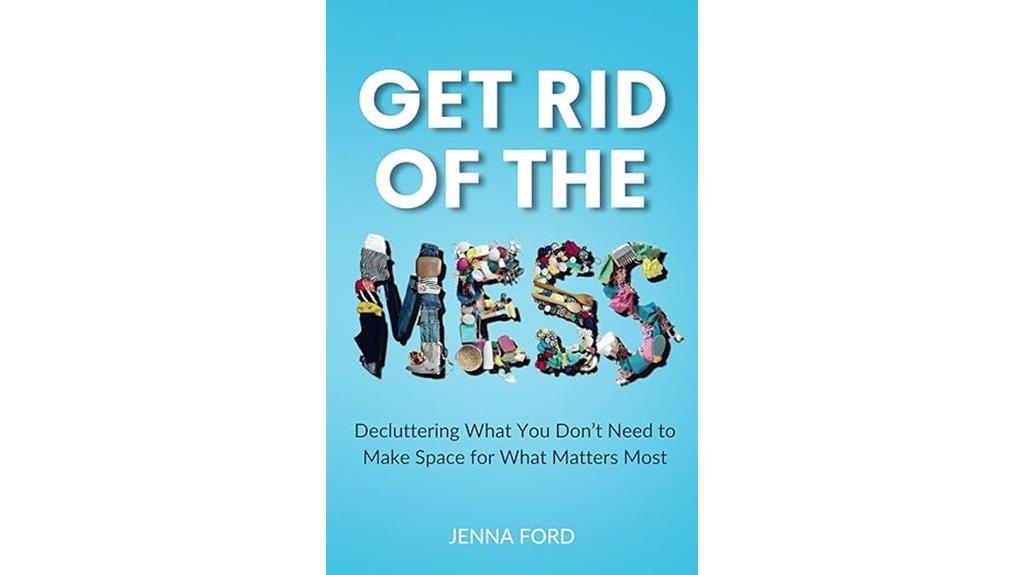
For anyone feeling overwhelmed by the chaos of clutter in their home, "Decluttering Essentials for a Fresh Start" offers a clear and compassionate roadmap to reclaiming your space. This guide breaks the decluttering process into manageable steps, helping you tackle one area at a time. With practical strategies and relatable insights, it addresses both the emotional hurdles and physical messes. Worksheets and examples encourage action, whether you're trashing, donating, or selling items. I've found that this supportive approach not only motivates me but also fosters personal growth, making the journey toward a clutter-free home truly transformative.
Best For: Individuals feeling overwhelmed by clutter who seek a structured, supportive approach to decluttering their spaces.
Pros:
- Provides a clear roadmap with manageable steps to tackle clutter.
- Addresses emotional challenges associated with letting go of items, fostering personal growth.
- Includes practical worksheets and examples for actionable decluttering strategies.
Cons:
- May require a significant time commitment to see results.
- Some readers may find the emotional insights challenging to confront.
- The structured approach might feel restrictive to those who prefer a more flexible method.
Decluttering Workbook: The Essential Guide to Organize and Declutter Your Home and Life
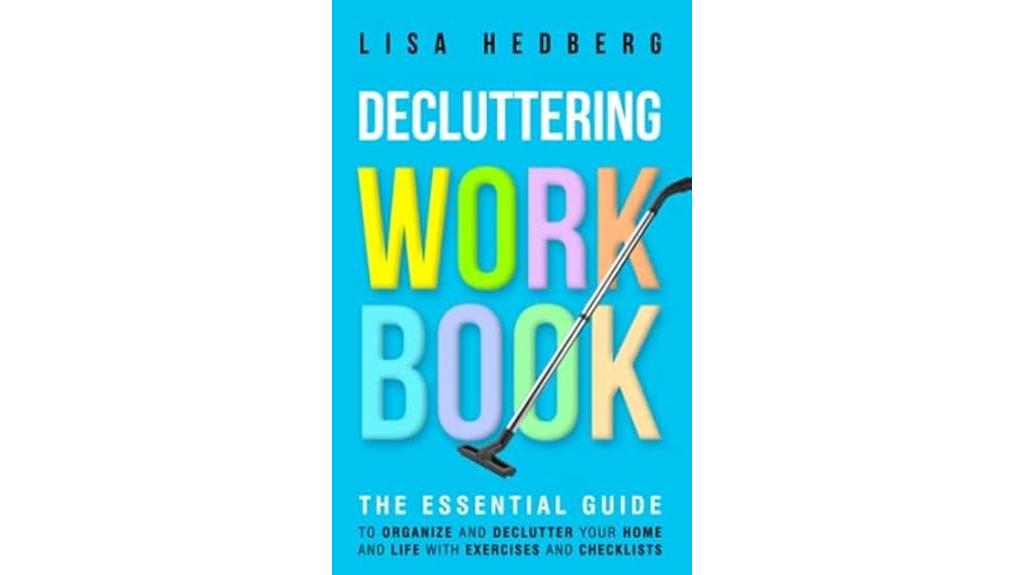
The *Decluttering Workbook: The Essential Guide to Organize and Declutter Your Home and Life* is perfect for anyone feeling overwhelmed by clutter and seeking a practical approach to regain control. Lisa Hedberg's workbook offers clear, empathetic guidance through exercises and checklists, making it easy to tackle clutter. I love how it emphasizes decluttering as a lifestyle change, encouraging small steps that fit into my busy day. The structure balances self-reflection and hands-on tasks, allowing me to create lasting habits. Plus, the additional downloadable resources and audiobook make this journey even more accessible. It's a game-changer for anyone ready to declutter!
Best For: Individuals feeling overwhelmed by clutter and seeking practical guidance to organize their homes and lives.
Pros:
- Offers clear, empathetic guidance through exercises and checklists.
- Emphasizes decluttering as a lifestyle change with manageable steps.
- Includes additional resources such as downloadable materials and an audiobook for convenience.
Cons:
- May require consistent commitment, which can be challenging for some.
- Exercises might feel repetitive for those already familiar with decluttering strategies.
- The workbook's conversational tone may not resonate with everyone.
Tidy Spaces, Peaceful Mind: The Art of Decluttering
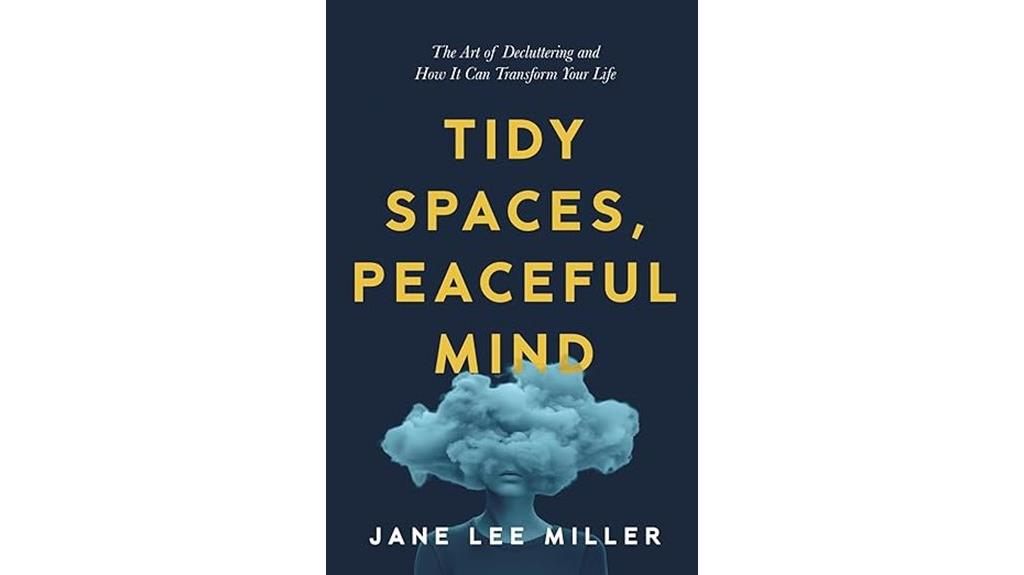
Creating a serene and organized living space is essential for anyone feeling overwhelmed by clutter. I found Jane Lee Miller's book, "Tidy Spaces, Peaceful Mind," to be a game-changer. Her practical strategies, like micro-decluttering, make tackling chaos manageable. By focusing on one small area at a time, I learned how to sort and categorize my belongings effectively. This process not only clears physical space but also brings a sense of calm. Miller emphasizes the psychological benefits, reminding me that a tidy environment fosters mindfulness and empowerment. Decluttering truly transforms my mindset, making the journey feel less like a chore and more like a path to peace.
Best For: Individuals seeking to create an organized and serene living space while improving their mental well-being.
Pros:
- Practical Strategies: Offers step-by-step techniques like micro-decluttering to simplify the decluttering process.
- Psychological Benefits: Emphasizes the mental well-being gained from a tidy environment, promoting mindfulness and empowerment.
- Engaging Writing Style: Miller's casual and motivational tone makes the content relatable and inspiring.
Cons:
- Repetitive Sections: Some parts may feel overly chatty or repetitive, potentially losing reader engagement.
- Limited Anecdotes: Lacks real-life stories that could enhance the relatability of the strategies presented.
- Insufficient Digital Decluttering Guidance: Does not delve deeply into decluttering digital spaces, which is increasingly relevant in today's tech-driven world.
Factors to Consider When Choosing The Decluttering Essentials Every Messy Home Needs
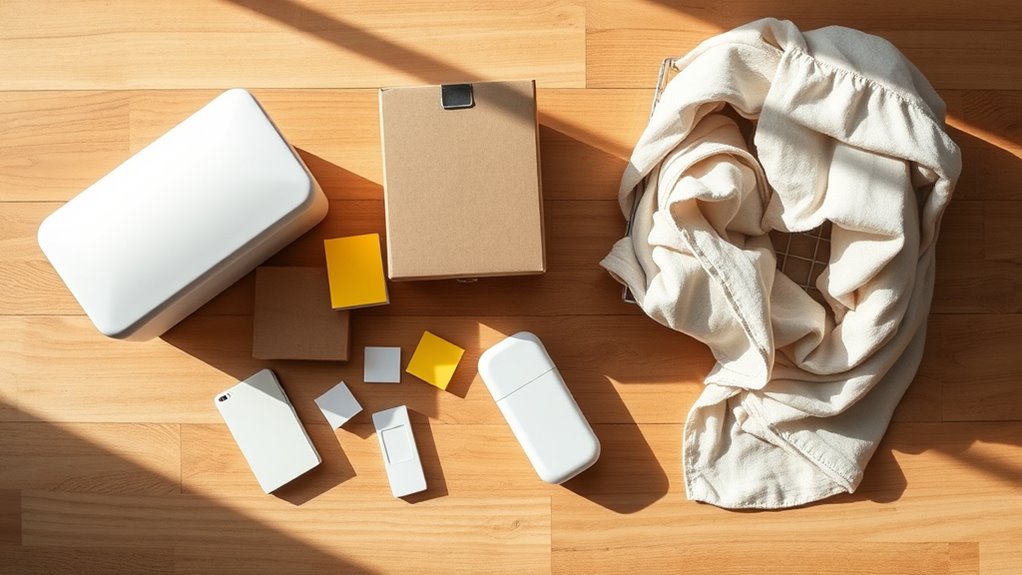
When I think about decluttering essentials, I realize it's vital to assess my personal clutter needs first. I also have to take into account my emotional attachments to items and the practicality of the tools I choose. By taking a room-by-room approach, I can guarantee I maintain a sustainable organization system that truly works for me.
Assessing Personal Clutter Needs
As I plunge into decluttering, understanding my personal clutter needs becomes essential for a successful transformation. I take a moment to assess which items contribute most to my clutter—clothing, books, or sentimental objects. This helps me prioritize where to start. I also identify specific clutter triggers, like my procrastination or shopping habits, which shed light on my relationship with clutter. I remind myself that decluttering isn't just a one-time event; it's a lifestyle change that requires sustainable habits. Finally, I evaluate my current storage solutions to see what works and what doesn't. By addressing these factors, I can create a more organized and manageable living space that truly reflects my needs and lifestyle.
Emotional Attachment Considerations
While I immerse myself in the decluttering process, I quickly realize that emotional attachments to my belongings can complicate my decisions. It's easy to feel guilty about letting go of gifts or items tied to memories. However, I remind myself that those gifts shouldn't feel like obligations. Throughout this journey, I've experienced enlightening "a-ha" moments, helping me confront my feelings and prioritize what truly brings me joy. Understanding the psychological reasons behind my clutter empowers me to tackle these emotional challenges. I've learned to view decluttering as a necessary lifestyle change, not just a one-time task. This shift in mindset helps me navigate the complexities of letting go, making the process feel more liberating than burdensome.
Practicality of Tools
Choosing the right decluttering tools can make all the difference in transforming a chaotic space into an organized haven. I always prioritize versatile items that can serve multiple purposes, like storage bins that fit in various rooms. Ease of use is essential; tools that are simple to handle and access really enhance my decluttering efforts. I also look for tools that promote organization, such as clear bins, which help me see the contents at a glance. Durability matters too—investing in high-quality materials means I won't need constant replacements. Finally, I assess my available space for storage solutions. Compact options that fit well in designated areas help me maximize efficiency and keep clutter at bay.
Room-by-Room Strategies
Decluttering a home can feel overwhelming, but breaking it down room by room makes the task manageable and less stressful. I find that focusing on one area at a time allows me to really assess what I want to keep, donate, or discard. Grouping like items together, such as clothing or books, streamlines the process and makes decision-making easier. Establishing clear goals and time limits for each room keeps me motivated, and I love checking off my progress with a checklist. It's satisfying to see each space transform! Ultimately, I incorporate regular maintenance routines to help prevent clutter from sneaking back in. This structured approach truly makes a difference in achieving a clutter-free home.
Maintenance and Sustainability
To maintain a clutter-free home, I've found it essential to develop sustainable habits that prevent mess from creeping back in. I set aside specific time each week for tidying, which helps keep clutter at bay. Adopting a "one in, one out" rule for new purchases encourages me to be mindful and reduces the chance of accumulating more items. I also reassess my belongings every season or during major life changes, ensuring everything I keep is relevant and necessary. Using clear storage solutions with labels makes it easy to find and return items to their designated places. Finally, involving everyone in my household fosters shared responsibility, making it easier to maintain our tidy space together.
Frequently Asked Questions
How Do I Start Decluttering When Feeling Overwhelmed?
When I feel overwhelmed by clutter, I start small. I pick one area, like a drawer or a shelf, and set a timer for just 15 minutes. I focus on sorting items into keep, donate, and trash. It's amazing how much lighter I feel after just a short session. I remind myself it's okay to take baby steps; progress is progress, no matter how small. Celebrate those little victories; they motivate me to keep going!
What Are the Benefits of Decluttering for Mental Health?
When I started decluttering, I noticed a significant boost in my mental health. Clearing out my space helped clear my mind, reducing feelings of anxiety and stress. I felt more in control of my environment, which lifted my mood. Each item I let go of felt like a weight lifted off my shoulders. It's amazing how a tidy space can spark creativity and bring about a sense of peace in my daily life.
Can Decluttering Help Improve My Productivity?
Absolutely, decluttering can boost my productivity! When I clear away the chaos, I find it easier to focus on tasks. A tidy space helps me think more clearly and reduces distractions. I've noticed that I'm more motivated to get things done when my environment is organized. Plus, it saves me time searching for things. So, if I want to enhance my efficiency, tackling clutter is definitely a step in the right direction!
How Often Should I Declutter My Home?
I usually declutter my home every three months. It keeps things manageable and prevents clutter from piling up. I find that seasonal changes inspire me to reassess what I really need. Sometimes, I'll do a quick declutter every month, especially in high-traffic areas. It helps me stay focused and organized, making my space feel fresh and inviting. You might want to try a similar routine to see what works best for you!
What Eco-Friendly Options Are Available for Decluttering?
They say, "One man's trash is another man's treasure," and that's especially true for decluttering. I've found several eco-friendly options that really work. First, I donate items to local charities or thrift stores. I also love using online platforms like Freecycle or Facebook Marketplace to give things away. For recycling, I check local guidelines to guarantee I dispose of materials properly. It feels great to declutter while being kind to the planet!
Conclusion
To sum up, embracing decluttering essentials can transform your home into a serene sanctuary, much like clearing the fog to reveal a bright, sunny day. By focusing on what truly matters, you'll create space for peace and clarity in your life. Remember, it's not just about tossing items away but about making intentional choices that reflect who you are. So, take that first step today, and watch as your messy home evolves into a haven of tranquility.
